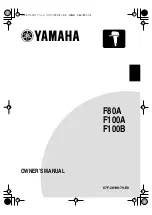
6-26
BajaPPC-750: VMEbus Interface
AM0-AM5
ADDRESS MODIFIER (bits 0-5). Three-state lines that are used to broad-
cast information such as address size and cycle type.
AS*
ADDRESS STROBE. A three-state signal that indicates when a valid
address has been placed on the address bus.
BBSY*
BUS BUSY. An open-collector signal driven low by the current master to
indicate that it is using the bus. When the master releases this line, the
resultant rising edge causes the arbiter to sample the bus request lines
and grant the bus to the highest priority requester. Early release mode is
supported.
BCLR*
BUS CLEAR. A totem-pole signal generated by the arbiter to indicate
when there is a higher priority request for the bus. This signal requests
the current master to release the bus.
BERR*
BUS ERROR. An open-collector signal generated by a slave or bus timer.
This signal indicates to the master that the data transfer was not com-
pleted in the time alloted (64 or 128µs).
BG0IN*-BG3IN*
BUS GRANT (0-3) IN. Totem-pole signals generated by the arbiter and
requesters. Bus-grant-in and bus-grant-out signals form bus grant daisy
chains. An input to the BajaPPC-750, the bus-grant-in signal indicates
that it may use the bus if it wants.
BG0OUT*-BG3OUT*
BUS GRANT (0-3) OUT. Totem-pole signals generated by requesters. An
output from the BajaPPC-750 (driven by boards not requesting the bus,
in response to the bus-grant-in signals), the bus-grant-out signal indi-
cates to the next board in the daisy-chain that it may use the bus.
BR0*-BR3*
BUS REQUEST (0-3). Open-collector signals generated by requesters.
Assertion of one of these lines indicates that some master needs to use
the bus.
D00-D31
DATA BUS. Three-state bidirectional data lines used to transfer data
between masters and slaves.
DS0*, DS1*
DATA STROBE ZERO, ONE. A three-state signal used in conjunction with
LWORD* and A01 to indicate how many data bytes are being transferred
(1, 2, 3, or 4). During a write cycle, the falling edge of the first data strobe
indicates that valid data are available on the data bus.
DTACK*
DATA TRANSFER ACKNOWLEDGE. Either an open-collector or a three-
state signal generated by a slave. The falling edge of this signal indicates
that valid data are available on the data bus during a read cycle, or that
data have been accepted from the data bus during a write cycle. The ris-
ing edge indicates when the slave has released the data bus at the end of
a read cycle.
Содержание BajaPPC-750
Страница 2: ...BajaPPC 750 PowerPC Based Single Board Computer User s Manual May 2002...
Страница 4: ...BajaPPC 750 PowerPC Based Single Board Computer User s Manual May 2002...
Страница 7: ......
Страница 16: ...0002M621 15 ix Register Map 9 1 Counter Timer Status CTSR 9 2 Register Map 9 2 Counter Timer Mode CTMR 9 4...
Страница 19: ...xii BajaPPC 750 Contents...
Страница 57: ...3 12 BajaPPC 750 Central Processing Unit May 2002...
Страница 77: ...5 12 BajaPPC 750 PMC PCI Interface May 2002...
Страница 111: ...6 34 BajaPPC 750 VMEbus Interface May 2002...
Страница 135: ...8 18 BajaPPC 750 Serial and Parallel I O May 2002...
Страница 207: ...10 68 BajaPPC 750 Monitor May 2002...
















































